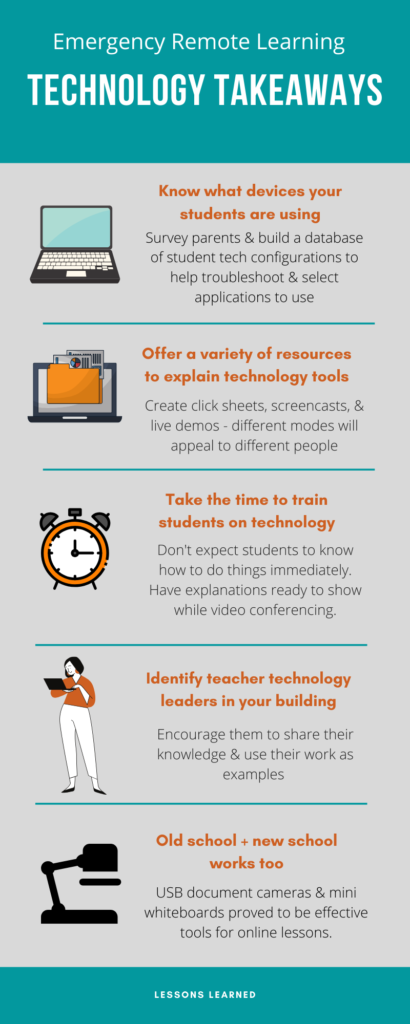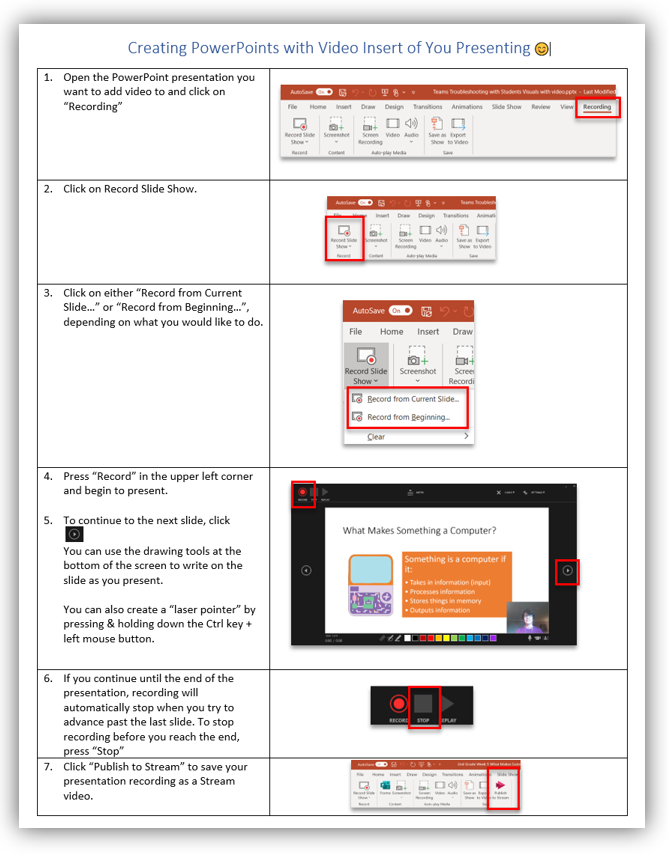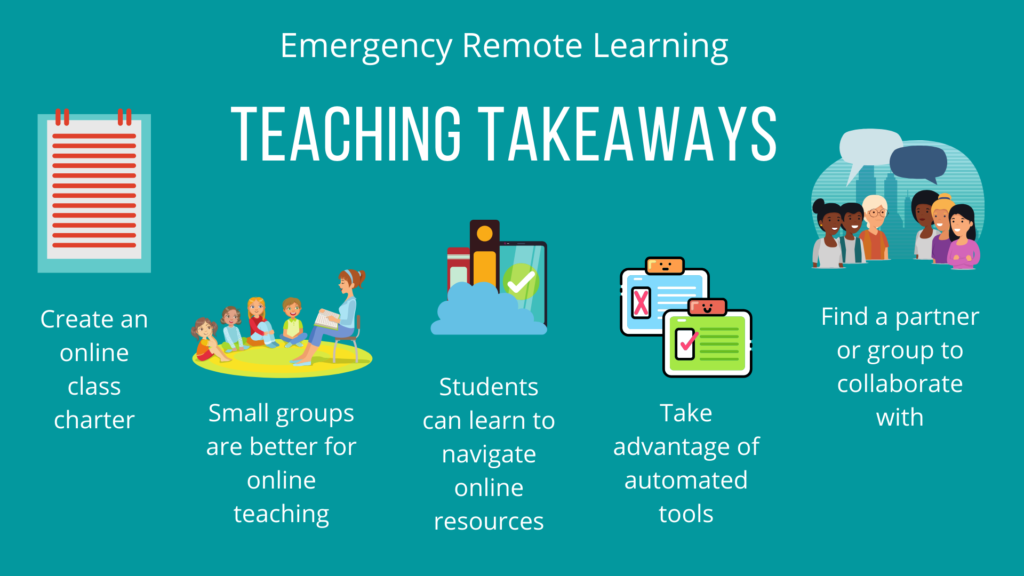
Introduction
The final quarter of Seattle Pacific University’s Digital Education Leadership (DEL) program includes a practicum in which students usually take on a special project and document the process in a final blog post. Due to the Covid-19 outbreak, we have been allowed to use our “regular” work experience as our practicum.
In this post, I will describe my own learning as a technology specialist, as well as insights from teachers and the Instructional Technology Curriculum Leader (ITCL) I worked with during the past three months of emergency remote learning. Though we are still in the thick of things and don’t know the long term effects this closure will have on students, I think it is important to reflect on the experience as best we can, and I am grateful for the opportunity that this practicum provided.
Background
I work in a public elementary school teaching computer science concepts and coding, as well as general tech skills. In mid-March, however, the job I was hired for abruptly changed to helping teachers and students with tech issues and assisting our ITCL and other technology specialist in training teachers and students on Teams, OneNote and other apps.
As things began to settle down last month with respect to training and troubleshooting, I was able to return to teaching, though this time working with small groups of students over Teams.
As difficult as this time has been, it provided a unique opportunity to apply so much of what I have learned in the DEL program: researching ed tech solutions, providing teachers with ways to more easily learn and apply technology, listening to educator’s concerns, and trying to support and integrate the district’s vision of technology at the local level.
Methodology
To document the process for this practicum I used my own notes, artifacts, emails and chats to help me remember issues, questions and solutions, particularly from the early days of the closure when things were a blur. I also interviewed five teachers and our ITCL, asking the following questions1:
- What have been the most challenging aspects of remote teaching/learning for you and your students?
- Are there any specific practices/tools you found indispensable during this time?
- Is there any practice you began or digital tool you started to use for remote learning that you will continue to use in your physical classroom?
- If you could give one piece of advice to help someone prepare for this situation, what would it be?
District Technology Tools
Our district uses Windows PCs, Microsoft (Office) 365 and Teams. Though our high school and middle schools are one-to-one, elementary is not, so the district has provided Lenovo tablet PCs and mobile hotspots to families that need them.

Other applications that were approved for use by teachers and students for elementary and used in my school include Microsoft OneNote, Near Pod, Lexia, Freckle, Ras-Kids, Dream Box, FOSSweb, Think Central, Newsela, and Clever.
Remote Teaching & Learning Challenges
I think it is helpful to examine the challenges for remote teaching and learning in two phases. The early days of the shutdown were a unique situation that hopefully will never happen again, but lessons learned can apply to any emergency closure. Ongoing challenges are things that we will continue to face as we transition to a hybrid instructional model in the fall or deal with future closures caused by Covid-19.
Early Days
It is probably obvious to anyone that closing school on a Friday and beginning remote teaching a little over a week later would be stress-inducing for all. On one hand, I applaud my district for taking the challenge head-on, and I appreciate their dedication to getting devices out to all students. On the other hand, there was very little time for teachers to plan or learn how to use the tools such as Teams and OneNote that were crucial for communicating with students and delivering lessons. In my opinion, however, everyone, including the district leaders, and in particular our principal, did the best they could in dealing with a difficult and ever-changing situation.
Advice Born of Experience
When asked what advice they would give to prepare for a situation like this in the future, teachers responded:
- “Start small.” Don’t try to do everything at once and “recognize your own capacity.” “Start with one or two subjects and the tools you know and set incremental goals each week.”
- “Be as organized as you can be.”
- Use the situation to model for your students that things don’t have to be perfect and that it is ok to change based on what you learn.
- “Give yourself grace. You will change your approach a million times and that’s ok.”
- Recognize that the situation is difficult for students too. They can only be ready for so much at a time.
- “Sit as a staff and put parameters in place: what does the bare minimum, common landing place and bonus work” look like for remote instruction?
- “Don’t be afraid to ask for help. This is a time to lean on your colleagues and share the load.”
- “Fear not and forge forward!”
Continuing Challenges
“…I understand it’s more important than ever to work from a human-centered lens because I have no idea what’s happening right now in students’ hearts, minds, and homes.”
4th Grade Teacher
Students Not Participating
Probably the most serious and ongoing challenge is that not all students are fully or even partially participating. A second-grade teacher at another school in the district said only about half her kids are turning in work on a regular basis. “The whole system depends on kids having parents who advocate for them,” she said. And we know those parents may be struggling with their own job responsibilities or unemployment in addition to helping educate their children.
Less Time for Key Subject Matter
The district reduced the amount of instructional time for various grade levels to: K-1: 45 minutes; 2-3: 60 minutes; 4-5: 90 minutes. This lowered pressure on teachers in terms of the volume of lessons they had to create, but increased concern regarding how they would cover subject matter sufficiently. As one teacher said, “One math lesson can take 90 minutes [under normal circumstances]!”
Other Continuing Challenges
- The self-management and independence that remote learning requires can be very difficult for this age group, as our ITCL pointed out.
- The amount of time it takes to modify lessons for the online medium, only to find that just a portion of the class completes them, as one teacher said.
- Persistent tech challenges – in my own tech lessons there is often at least one student who can’t share their screen due to certain hardware configurations or who has sound or connection issues. Another chronic issue includes OneNote not syncing properly, delaying lesson distribution.
- Many of the tools we are using, including Teams and OneNote, were not designed for young children. Staff continue to struggle with monitoring Teams chats, channel permissions, or having to help students navigate OneNote and other tools.
- Elementary school, especially in K-2 public schools, involves a lot of paper-based assignments. Many students don’t have access to printers or touch screens. Some of this has been mitigated by online tools such as OneNote, ThinkCentral, or Freckle, but it has been one of the biggest issues in delivering instruction and having students turn in work.
- ELL and students with special needs face greater difficulty with remote learning. Examples of typical situations include a student using the Mandarin version of Windows and therefore not seeing what his teacher was describing on the screen; a student with an IEP who likes to use a mouse at school but doesn’t have one at home and becomes frustrated.
- Asynchronous learning is a double-edged sword. Some students thrive with fewer distractions and a more flexible work schedule. Others struggle without easy access to teachers or social contact with friends. With fewer social cues like facial expressions and body language, teachers find it harder to know how their students are really doing.
“When asking my students about the most challenging aspect of remote learning, they tell me that they don’t feel like they’re being taught… I understand this sentiment as I feel less like a teacher and more like a tech support resource. Even with audio presentations, online whole group and small group check-ins, and availability on Teams to answer questions, there is an element of effective teaching which is lost because we’re not working together in person.”
4th Grade Teacher
Practices and Tools Worth Continuing
All of us have discovered that some things we had to do during this time could also be useful in hybrid or traditional brick and mortar settings. Probably the most significant is the importance of collaboration, particularly among grade levels, but even between disciplines and different grade levels. The closure has enabled me to better know the educators in my building, as well as understand, through OneNote or conversations, their teaching methods during this time.

Other practices and tools that the teachers I interviewed said they might use next year include OneNote for student work and lesson planning; Near Pod for its ease of use and the variety of presentation and assessment tools; Lexia, for its assessment and targeted learning lessons; and Synergy for keeping track of assignments. Synergy has been used in the district for a while, but many teachers had not taken advantage of this feature.
Technology Take-aways
As difficult as this time has been, I have appreciated the accelerated learning that has led to a deeper understanding of the apps and technology we use in the district. The figure below describe my top-level learning from the past three months, and is followed by a more detailed description.

Build a database that identifies the type of device each student is using for remote learning. In a situation where all students do not have a standard school-issued device, this helps immensely with troubleshooting. Before starting my online tech classes, I sent out a Microsoft Form that included a question on device use.

Knowing configurations also helps teachers plan which type of software to use for lessons and to even organize students into groups of like devices so instructions can be made pertinent to their configurations, reducing confusion. This may sound like putting technology before instruction, but if directions are written for a Windows PC, a child with an iPad will be confused. Another example is if teachers ask students to show their work by drawing in an app like Near Pod or OneNote, students without a touchscreen will have a difficult time.
Use a variety of modes to help students and teachers learn new technology tools, including click sheets, screencasts, and live demonstrations. Find a way to organize these tools and make them readily available.
I found that you can send tech tips out or place them in a central location, but (understandably) most teachers won’t pay attention to them unless they have a need at that time. The key is to have resources readily accessible so you can easily provide them when needed.


Take the time to train students in how to use the technology. Both 2nd grade teachers I interviewed said it took almost a month for students to become proficient at using Teams. One thing I found useful was to have PowerPoint slides loaded in the task bar to show how to use various Teams features, including screen sharing, since it is difficult to do this while in the middle of a virtual meeting.

Identify teacher tech leaders and encourage them to share how they are using various tools for either organization or lessons. A teacher who had taught in middle school and used OneNote in her classes quickly set up a OneNote for her fourth-grade classroom at the start of the school closures. She also held a training session for other teachers and kindly met with me to share tips on best practices which I was able to include, along with information from our building tech specialist, in one of two Tech Tips newsletters I created.
Old school + new school is ok. Several teachers said getting a document camera that allowed them to share handwritten or paper-based materials with students was a lifesaver. I witnessed another teacher write on a small whiteboard and hold it up to the camera and it worked fine.
Take advantage of single-sign-on (SSOs) applications such as Clever to make it easy for young students to access a variety of online tools.
Teaching Take-aways
The teachers I interviewed, and my own experience teaching small groups has uncovered the following helpful practices during remote instruction:

Create an online classroom charter or norms at the start of remote learning. Anticipate issues with chats, unsupervised student meetings, meeting behavior (such as students muting each other or kicking other students out of the meeting).
Small groups enable a better online experience for students, and it is easier to hold them accountable for work and (like a brick and mortar school) differentiate instruction. In one small group tech class I was teaching, I discovered two 4th grade students were using Python to show Math learning. I quickly changed what we were going to do to address their more advanced coding skills.
Take advantage of tools that do assessment or automate grading. Multiple teachers mentioned how glad they were that the district is now using Lexia. A second-grade teacher said she appreciated Think Central’s multiple-choice assessments and auto grading, as well as recommendations for intervention lessons.
Students (hopefully) are better at finding and utilizing resources. Though our students are young, many can easily navigate OneNote and Teams because of this experience. The ability to have an online repository of resources such as “how to” click sheets and screen casts that students can access can help make the more independent learners.
Find a partner, hopefully another grade-level teacher, to work with. Dividing the work and having someone to collaborate with can make a big difference in not feeling overwhelmed and isolated. I was helped tremendously by the Tech PLC that my principal requested we set up, as well as by my fellow tech specialist who also teaches technology classes.
Conclusion
I realize, in spite of the challenges to remote teaching and learning outlined above, how different our situation may be from other schools. We are in a district that had enough devices to hand out to every family who needed one, and though there are four Elementary schools that qualify for Title 1 status in our district, our school is located in one of the wealthier areas of the city.
All students will be behind if and when we return to our buildings in the fall, but lower income, students of color, and students who live in rural areas will be the most effected. An analysis by McKinsey & Company cited in a recent New York Times article predicts that the average student could lag seven months academically, while black and Hispanic students may fall behind as much as nine to ten months due to the pandemic. The article also stated that only 27 percent of rural districts required any instruction during the closure (Goldstein, 2020).
In light of these numbers, the challenges and takeaways cited above seem trivial. But hopefully the difficulties of our current time have heightened public awareness of systemic inequality, leading to change in how educational resources are funded and distributed in the future.
Footnotes
1 I modified the questions for the ITCL as follows:
- What have been the most challenging aspects of helping to implement remote teaching/learning for you?
- Are there any specific practices/tools you or teachers you work with found indispensable during this time?
- Is there any practice you began or digital tool you started to use for your own work as an ITCL that you will continue to use even when things return to “normal”?
- Are there any remote learning practices or tools that you think teachers will continue to use once things return to normal?
- If you could give one piece of advice to help someone prepare for this situation, what would it be?
References
Goldstein, D. (June 6, 2020). Research shows students falling months behind during virus disruptions. The New York Times. Retrieved from: https://www.nytimes.com/2020/06/05/us/coronavirus-education-lost-learning.html?searchResultPosition=2